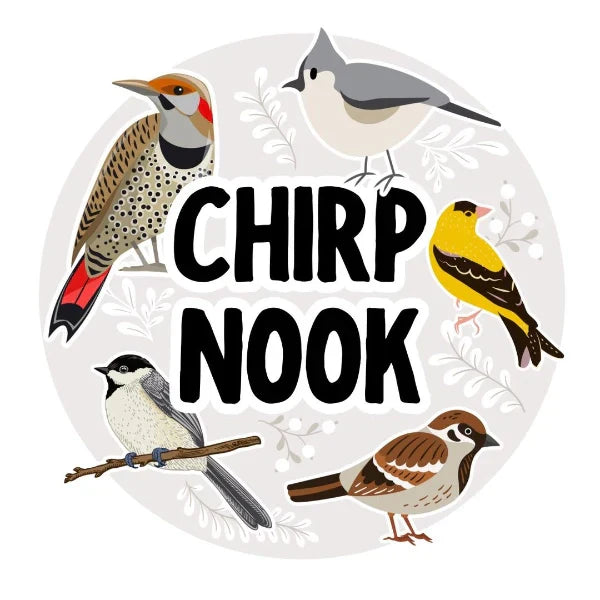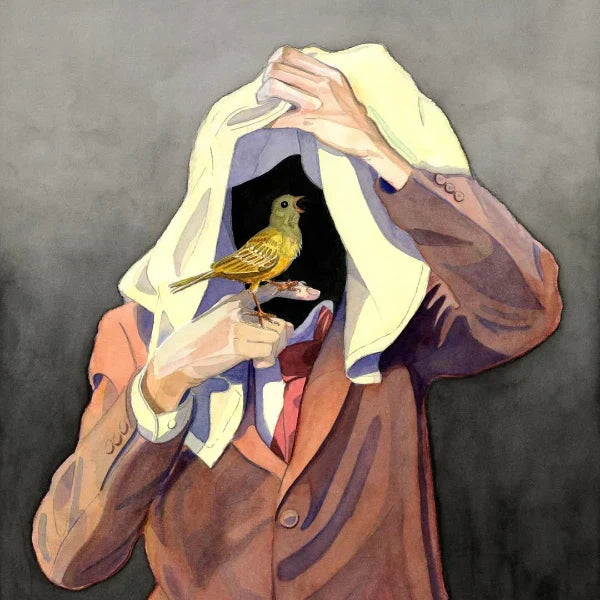Do not let the parrot in the name fool you into thinking it resembles its multicolored relatives. In the remote jungles of New Guinea, a bird unlike any other roams the dense forest canopies. Renowned for its jet-black wings and blood-red belly, it looks like it stepped out of a slasher movie and has stained clothing. Meet the Dracula Parrot. With its otherworldly chimera look, this bird looks like something out of your darkest imagination.
But behind its gothic appearance is a bird species whose survival hangs in the balance. In this article, we'll explore Dracula Parrot's biology, habitats, and the myths surrounding it. Don't worry. We also answer the biggest question: Does it suck blood like its Transylvania namesake? Get ready to encounter yet another of the world's oddest birds.

What's in a Name?
The scientific name of the Dracula Parrot is Psittrichas fulgidus. The genus Psittrichas comes from the Greek words for "parrot" (psittake) and "hair" (trikkos), referring to its bizarre feather patterns. While Fulgidus means "shining" in Latin, it is derived from its shiny, bright, black-plumage color.
The Dracula Parrot is also called Pesquet’s Parrot, named after a 19th-century French figure, though little is known about the individual behind the name. The species was first described scientifically by René Lesson in 1835.

Meet the Dracula Parrot
Now, let's talk about the Dracula Parrot. The bird is not easy to overlook. At 46–50 cm in length and a maximum weight of 900 grams, the Dracula Parrot is large and sizable. The body is jet black, but the blood-red chest and belly will grab your attention instantly.
But what truly sets this parrot apart is its naked face. Instead of feathers, it has smooth black skin, like a vulture. The curved beak is adapted for consuming figs and other soft fruits deep within the dense rainforest.
Furthermore, the Dracula Parrot moves deliberately across the trees, more like a vulture than the cheerful parrots you've seen. Instead of a lively, cheerful sound, it gives a harsh, growling voice, as if the appearance is not scary enough.

Home Among the Clouds: Habitat, Breeding, and Family Life
The Dracula Parrot dwells in the mountain rainforests of New Guinea at elevations of 600 to 2,000 meters. It is a canopy dweller, living in old-growth forests with plentiful fig trees, which it depends on.
In breeding, Dracula Parrots are monogamous and establish long-term pair bonds with one mate. The pairs are territorial and will defend the nest from intruders. They breed in high tree hollows, and the female lays one or two eggs. Parental duties are done together. The parents regurgitate the fruit pulp to feed the chicks until they can care for themselves.
However, the parrot's slow breeding rate and habitat destruction make population recovery extremely slow. Dracula birds are very dependent on old trees for breeding. As deforestation increases, the parrot's survival chances decrease.

A Special Diet: What Does the Dracula Parrot Eat?
So, does the great Dracula Parrot drink blood like a vampire? Well, no. The Dracula Parrot's diet consists mainly of chewing ripe figs, which they have in abundance in their mountain rainforest environment. Its naked face prevents the bird's sticky fruit pulp from dirtying its feathers.
This parrot's selective eating habit sets it apart from the other active and loud parrot species. It forages in small groups or alone, selecting only the ripest fruits.

Social Behavior
The Dracula Parrot is relatively solitary or in small family groups. It is territorial, with breeding pairs defending nest sites and feeding areas actively. In contrast to more social parrot species, which are found in huge flocks, the Dracula Parrot is reserved. Its slow, labored flight and cautious foraging resemble a vulture rather than a parrot species.
Myths and Legends about the Dracula Parrot
Due to its appearance and supernatural call, it is no surprise that the Dracula Parrot has spawned myths and legends. In New Guinea, some native residents believe the bird is somehow connected with the spirits or omens. These birds are seen as a medium connected to the spirit world.
Due to its vampire-like appearance, the Western world has made the Dracula Parrot a household name as an Internet celebrity. Its "goth bird" celebrity status has created unbelievable urban myths and memes on the Internet.

Trouble in Paradise: Threats to the Dracula Parrot
Despite its fearsome name, the Dracula Parrot faces very real and growing threats in the wild. The most pressing danger comes from habitat destruction, as large portions of New Guinea's lowland and montane rainforests are cleared for logging, agriculture, and mining operations. These lush forests are essential not just for shelter and breeding but also for providing the fruit-rich diet the species relies on.
Adding to its vulnerability is the parrot's low reproductive rate. Dracula parrots form monogamous pairs and typically raise only one or two chicks per breeding season. This slow population growth rate makes it difficult for the species to recover from losses, especially in areas where their habitat has been severely fragmented.

Another significant threat is poaching. Though not commonly kept as pets due to their specialized diet and care needs, their dramatic appearance makes them highly desirable in the illegal wildlife trade—particularly for their striking red and black feathers, which are sometimes used in traditional ceremonies or sold as exotic curios.
As a result of these combined pressures, the Dracula Parrot is currently listed as Vulnerable on the IUCN Red List.
Conservation Efforts and Scientific Research
The silver lining? Finally, human beings are waking up and taking steps to rescue this incredible bird. Dracula Parrot conservation involves habitat preservation. National parks and protected areas in New Guinea are trying to establish significant breeding and foraging habitats for the species. The primary aim is to protect the parrot's rainforest habitats from development and logging.

Also, scientists are tracking the habits of the parrot so that they can learn more about what the bird requires. Tracking devices, like smart bird feeders and population surveys, allow scientists to monitor the parrot population in the wild.
Local residents also play an important role in preempting poaching and conserving the bird's habitat. In liaison with conservation agencies, they educate people to save this incredible bird.
Interesting Facts About the Dracula Parrot
- The sole member of its genus: The Dracula Parrot is the sole member of the genus Psittrichas.
- Parrot like a vulture: It has its feathers like a vulture, though the Dracula Parrot is a frugivore and exists on fruit alone.
- A pretty nimble flier: Despite its large size, the Dracula Parrot flies really agilely amidst the dense rainforest canopies.

Final Thoughts
With its dark feathers and striking red chest, the Dracula Parrot looks like it flew out of a horror movie—but it's undeniably stunning. But it's more than just a bird that is cool-looking. It helps rainforests grow by spreading seeds and quietly working for nature. Sadly, its home is being destroyed, and illegal trade looms over it. Saving the Dracula Parrot isn't just about a single species of bird; it's about preserving entire ecosystems.
By saving birds such as these, we are saving the future of our forests. Wouldn't it be wonderful if future generations could see these birds with their eyes, not just pictures?
If you enjoyed learning about this gothic rainforest dweller, don’t miss our deep dive into another bizarre bird: the Potoo. Its haunting appearance and eerie nighttime calls are just as unforgettable.

FAQs
1. Is the Dracula Parrot a good pet?
The Dracula Parrot is a fascinating species but not suited for the average pet owner. It is a wild bird, highly adapted to its natural environment, and has a very specialized diet of figs and other soft fruits that is difficult to replicate in captivity.
2. Is it illegal to own a Dracula Parrot?
Yes, owning a Dracula Parrot is illegal in many parts of the world due to its protected status. The species is listed as Vulnerable on the IUCN Red List and is protected under international wildlife trade regulations such as CITES (Convention on International Trade in Endangered Species). Because of its rarity, specialized diet, and conservation concerns, capturing or selling Dracula Parrots is highly restricted or outright banned in most countries.
3. Do Dracula Parrots eat meat?
No, Dracula parrots are strict frugivores, meaning they eat fruit—especially figs—and do not consume meat. Despite their ominous name and vulture-like appearance, they don’t eat flesh or prey on other animals. Their bare facial skin, similar to scavenging birds, is simply an adaptation for eating sticky fruit without making a mess of their feathers.
4. What is the rarest parrot in the world?
One of the rarest parrots in the world is the Spix’s Macaw, also known as the Little Blue Macaw. Native to Brazil, it was once declared extinct in the wild, with only a few surviving individuals in captivity. Thanks to intensive conservation efforts, some Spix’s Macaws have recently been reintroduced into their natural habitat. While the Dracula Parrot is rare and vulnerable, the Spix’s Macaw is often cited as the most critically endangered parrot species globally.
5. How big is the Dracula Parrot compared to other parrots?
The Dracula Parrot is one of the largest parrots in existence. Standing 45–50 cm tall and weighing up to 900 grams, it is far bigger than most parrots. It is roughly on the level of other large parrots like the macaws but slightly smaller compared to them.




Leave a comment
All comments are moderated before being published.
This site is protected by hCaptcha and the hCaptcha Privacy Policy and Terms of Service apply.